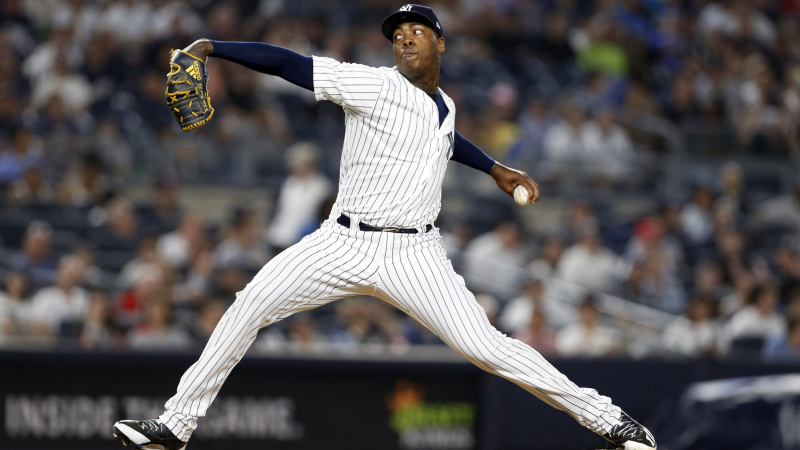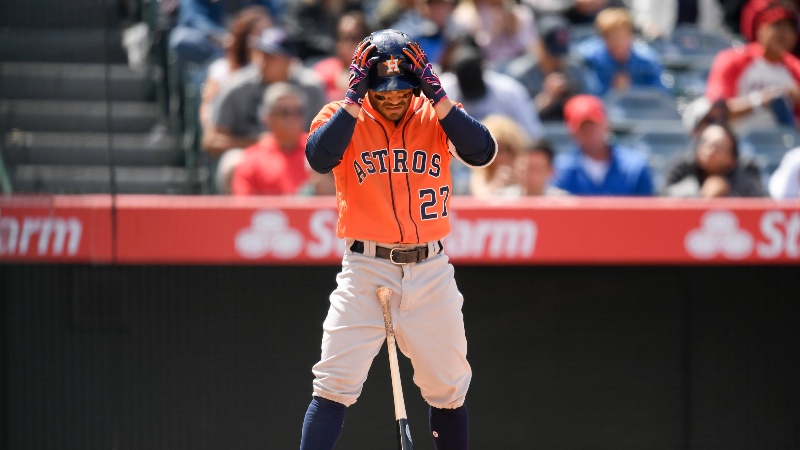The MLB All-Star Break is here, but now is no time for serious sports speculators to take a break. Even though baseball has the longest season of the four major professional sports, players can still experience extended bouts of variance that enable them to run cold. Based on Statcast data, career averages, and season-long trends, here are 10 players who seem likely to progress as fantasy producers in the second half of the season.
Batters
Rangers 1B/OF Joey Gallo
First-Half Stats
- .187 AVG, 22 HR, 48 R, 51 RBI, 3 SB
Even though his batting average has plummeted, Gallo has maintained his power, and there is a lot to like with him moving forward. He’s made soft contact on just 11.4% of balls in play, which is a career-best mark that ranks 10th in the league this season. His strikeout rate of 36.2% is absurdly high, but it’s actually slightly better than the mark he posted in 2017, when he averaged a Plus/Minus of +0.75 on DraftKings (per the Trends tool).
The biggest reason for his unsightly batting average is simply his reduced number of home runs. His HR/FB rate of 22.9% is more than seven percentage points lower than his 2017 mark and nearly five percent lower than his career average. That should bounce back in the second half given Gallo’s prodigious power, and when it does he’ll have a chance to be a repeat GPP winner.
Nationals OF Bryce Harper
First-Half Stats
- .214 AVG, 23 HR, 57 R, 54 RBI, 6 SB
Arguably no hitter in baseball has been unluckier than Harper during the first half of the season. He’s recorded a batting average on balls in play (BABIP) of just .226, which is drastically lower than his career average of .314. That he’s making more hard contact and less soft contact than he has made at any other point in his career reveals his low BABIP to be even more perplexing. He should be able to improve on his Plus/Minus of -1.02 on DraftKings in the second half assuming he doesn’t fall victim to the Home Run Derby curse.
Cardinals OF Marcell Ozuna
First-Half Stats
- .268 AVG, 10 HR, 38 R, 49 RBI, 2 SB
The Cards’ big offseason acquisition has been mostly a disappointment, averaging a Plus/Minus of -0.61 on DraftKings this year. That said, Ozuna had a good Statcast profile in the first half. He made hard contact on 46.6% of balls put in play, which was the 12th-highest mark in the league. The big reason for his statistical decline has been his dip in home-run production. His HR/FB rate of 23.4% last season is probably an outlier, but his current HR/FB rate of 10.9% is significantly lower than his career average (14.9%). Given that he’s making more hard contact than he’s ever made, there’s no reason he can’t reverse course in the second half.
Indians 1B Edwin Encarnacion
First-Half Stats
- .225 AVG, 22 HR, 48 R, 65 RBI, 0 SB
It’s easy to make the case that Encarnacion is on the decline in his age-35 season, but that conclusion is not supported by his 2018 Statcast data. He’s posted a career-high hard-hit rate of 42.7%, and his soft-contact rate of 14.2% is his lowest mark since 2012. He’s continued to hit home runs at a solid clip, but his overall numbers have been dragged down by a subpar BABIP of .230. The one big red flag with Encarnacion is his inflated strikeout rate of 23.2%, but he should see some progression on the balls he puts in play moving forward.
Royals C Salvador Perez
First-Half Stats
- .221 AVG, 13 HR, 27 R, 41 RBI, 1 SB
Perez started at catcher for the American League in the All-Star Game, but that doesn’t mean he’s having a good season. His average has dropped all the way to .221, thanks in part to an abysmal BABIP of .235. He’s making elite contact this season with career-best hard-hit and soft-contact rates, so he should be closer to his career BABIP of .285 over the second half of the season.
Pitchers
Indians Right-Hander Carlos Carrasco
First-Half Stats
- 11 W, 4.12 ERA, 112 Ks, 1.17 WHIP
Carrasco has posted an average Plus/Minus of -1.07 on DraftKings over the first half of the season, but I’m betting on a big bounceback following the All-Star Break. He remains a strong strikeout producer, averaging a K/9 of 9.82 through his first 18 appearances (per our MLB Models), but he’s been plagued by an unusually high BABIP of .313. Those hits have also come at inopportune times for Carrasco, who is stranding runners at a rate of just 72.1%. His FIP of 3.43 and xFIP of 3.37 are more in line with his career averages, so I would expect some progression from him in the second half.
Phillies Right-Hander Nick Pivetta
First-Half Stats
- 6 W, 4.58 ERA, 113 Ks, 1.32 WHIP
Like Carrasco, Pivetta is another pitcher whose FIP (3.75) is significantly lower than his traditional ERA. Pivetta has increased his strikeout rate and decreased his walk rate this season, both of which bode well for his long-term fantasy prospects. He’s also allowing fewer home runs per fly ball and inducing more ground balls this season. All that kept him from being a viable fantasy pitcher in the first half was an usually high BABIP of .329. If he can shave a few percentage points off that mark in the second half, he’ll have value.
Mariners Left-Hander James Paxton
First-Half Stats
- 8 W, 3.70 ERA, 155 Ks, 1.09 WHIP
Paxton put together a phenomenal first half, recording an average Plus/Minus of +3.72 on DraftKings, but he has the potential to be even better. Only four starting pitchers are averaging a higher K/9 than Paxton’s 11.69, but he has been plagued by a career-high HR/FB rate of 13.4%. Considering that Paxton allows fly balls at the 17th-highest rate in baseball, that’s a problem. However, he has a career HR/FB rate of just 9.8%, so there is reason to believe he can limit home runs moving forward. If he does, there’s nothing stopping him from becoming a truly elite fantasy pitcher.
Mets Right-Hander Zack Wheeler
First-Half Stats
- 3 W, 4.44 ERA, 106 Ks, 1.34 WHIP
Wheeler entered the big leagues as a hyped prospect but has largely failed to live up to expectations. However, he’s taken a lot of steps in the right direction in 2018, but that improvement hasn’t been reflected in his traditional numbers. Only two pitchers are generating more soft contact than Wheeler this season, and he’s posted a career-low walk rate of just 8.7%. As a result, his FIP of 3.73 is significantly lower than his ERA. Over his past six starts he has already seen his numbers improve, tallying 42 strikeouts and pitching to a 3.49 ERA over 38.2 innings, and he should continue to build upon his recent outings after the All-Star Break.
Rockies right-hander Jon Gray
First-Half Stats
- 8 W, 5.44 ERA, 125 Ks, 1.44 WHIP
Gray is a tough pitchers to peg. He has elite stuff, evidenced by a K/9 of 11.33 in 2018, but pitching for the Rockies means that approximately half of his starts take place in the worst pitching environment in baseball. However, Gray has actually posted a significantly better Plus/Minus at home (+5.32) than on the road (+0.15) this season, just as he’s done for most of his career.
Regardless of where Gray pitches in the second half, he seems due for better results. He owns MLB’s largest discrepancy between ERA and FIP this season thanks mostly to a ridiculous high BABIP of .376 and unusually low strand rate of 64.0%. With progression in even just one of those categories, he has the potential to be a valuable fantasy starter given his elite strikeout ability.
Pictured Above: Joey Gallo
Photo Credit: Tim Heitman-USA Today Sports







